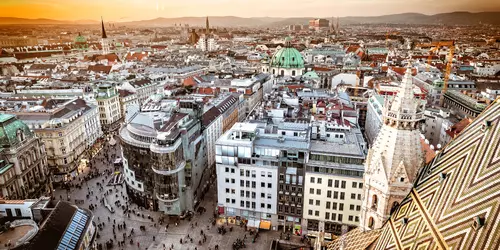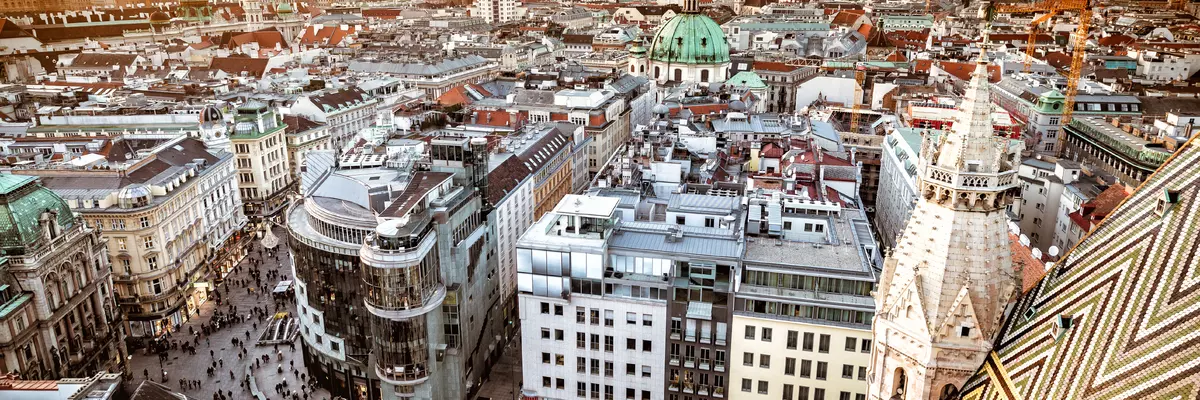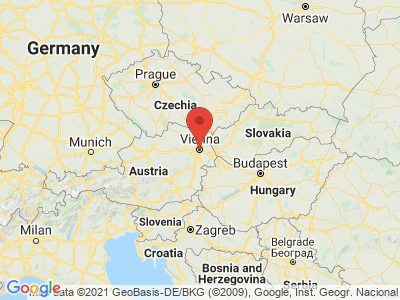Climate Table Vienna
Jan | Feb | Mar | Apr | May | Jun | Jul | Aug | Sep | Oct | Nov | Dec | |
|---|---|---|---|---|---|---|---|---|---|---|---|---|
| Max. Temperature | 1° | 3° | 8° | 14° | 19° | 22° | 25° | 24° | 20° | 14° | 7° | 3° |
| Min. Temperature | -4° | -2° | 1° | 5° | 10° | 13° | 15° | 15° | 11° | 7° | 3° | -1° |
| Sun Hours | 2 | 3 | 4 | 6 | 7 | 8 | 8 | 8 | 7 | 5 | 2 | 1 |
| Rain Days | 8 | 7 | 8 | 8 | 9 | 9 | 9 | 9 | 7 | 8 | 8 | 8 |
The climate year of Vienna
The Austrian capital Vienna is not only the largest city in the country, but also a metropolis of millions of European rank. Important United Nations (UN) institutions such as the High Commissioner for Refugees (UNHCR) or the International Atomic Energy Agency (IAEA) have their headquarters there. With its numerous historical buildings, especially from the time of the Habsburg Dual Monarchy, and its abundant cultural offerings, the city is one of the most popular destinations in Europe. Vienna is located in the so-called Vienna Basin on the eastern edge of the Alps. The Alpine foothills and the Pannonian Plain meet here. The city is therefore characterized by a transitional climate between an oceanic and a humid continental climate. Westerly weather conditions coming from the Atlantic are possible in the region, as well as easterly weather conditions influenced by the Pannonian Plain with strong Puszta winds. Only about half of Vienna's urban area is actually built-up. The rest consists of extensive green areas, some of which are also used for agriculture and invite visitors to go on excursions.
General information about Vienna
As the seat of the Emperor of the Holy Roman Empire of the German Nation, European history was decisively shaped from Vienna for centuries. Last but not least, a multi-ethnic state was also ruled from there. Both are still reflected today in the magnificent architecture of the old town. The Hofburg, Schönbrunn Palace, Belvedere Palace, the opulent Ringstrasse and the mighty St. Stephen's Cathedral are not among the city's most popular sights for nothing. But Vienna was also a center of art and culture. Above all, music and painting determined the cultural life of the city. Names such as Beethoven, Schubert, Strauss, Klimt and Schiele are therefore closely associated with the history of Vienna. Today, the Vienna State Opera is one of the most important opera houses in the world and the Vienna Philharmonic Orchestra is considered one of the best orchestras in the world. Numerous museums such as the Albertina or the Museum Leopold shine with important works of art, especially of the modern age.
Tourism Vienna
The climatic conditions in Vienna naturally change constantly throughout the year. The seasons are distinct and differ especially in temperatures. The two coldest months are January and February, which also have the fewest hours of sunshine. In contrast to many other regions of Austria, however, considerably less snow falls in Vienna during these months. In general, it is true that in the city area throughout the year rather less precipitation is to be expected. Overall, it can be assumed that there are only about seven to nine rainy days per month on average. By far the warmest months in Vienna are the months from May to September. The most hours of sunshine and the highest temperatures are usually reached in July and August. June, on the other hand, has the highest amount of precipitation. No wonder then that the summer months of June, July and August are the most popular months to travel. From October to December, the temperatures drop, sometimes quite significantly, while the amount of precipitation surprisingly hardly changes. It can get really cold already at the end of November and then especially in December.


